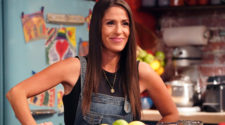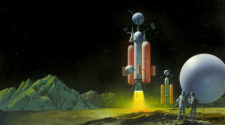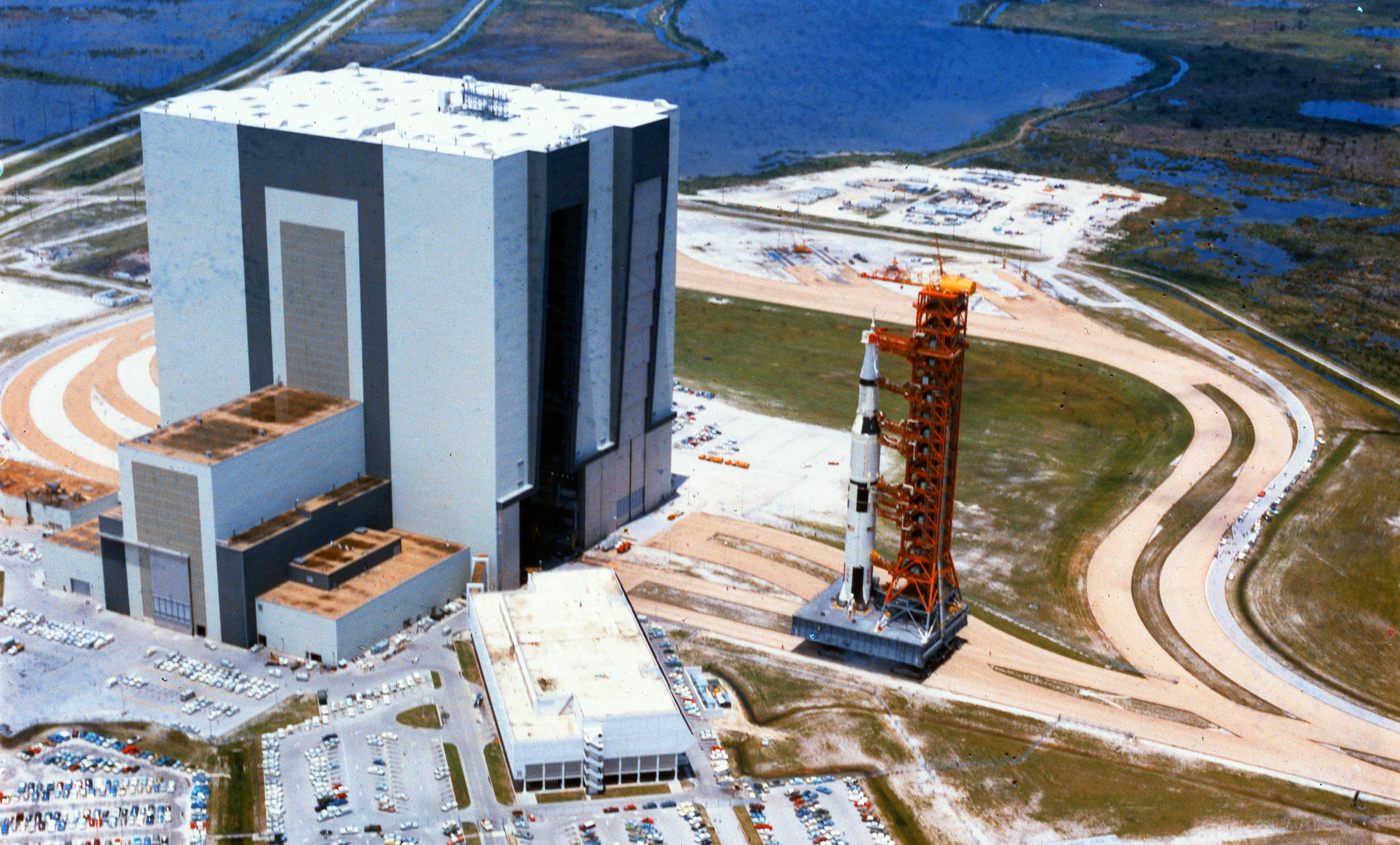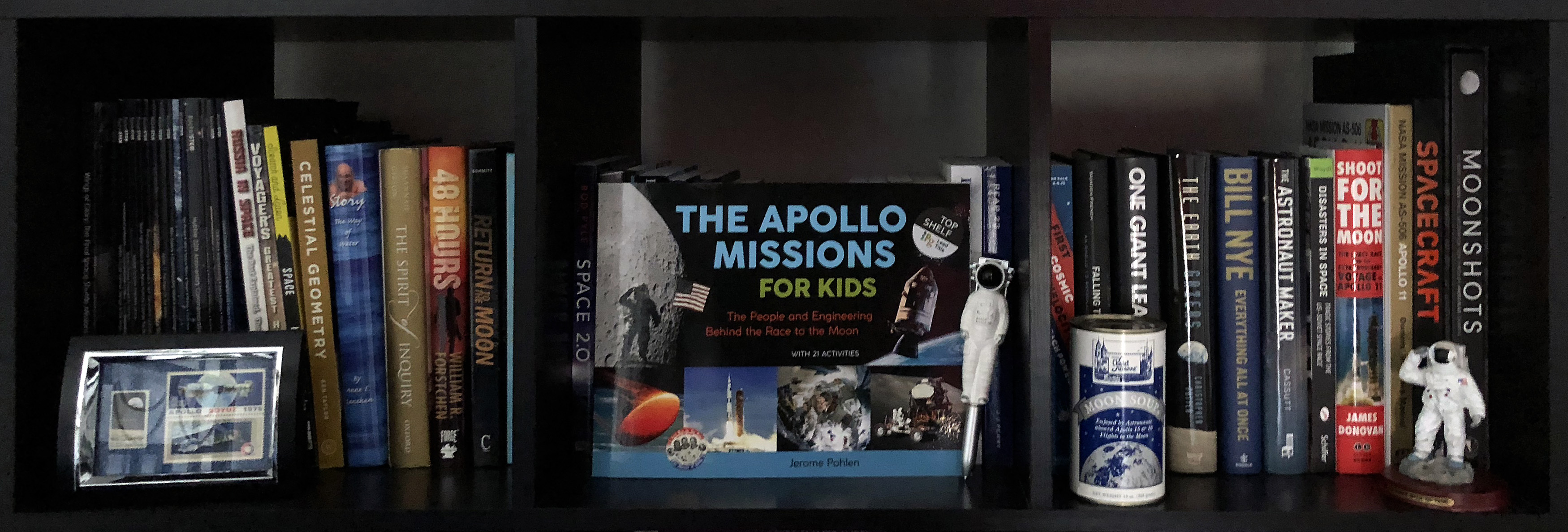
All across America and throughout the world, celebrations are being held this month to mark the 50th anniversary of Apollo 11’s first landing on the Moon. Well-traveled author Jerome Pohlen was just a kid when the Saturn V rockets were launching astronauts to the Moon from 1968 until 1972, but that era still has left a distinct impression upon his life. Last month, Chicago Review Press published his newest title, The Apollo Missions for Kids: The People and Engineering Behind the Race to the Moon. The book includes more than 20 activities that will provide children a more hands-on understanding of the challenges faced during the lunar landings.
Pohlen is a former elementary school science teacher, a mechanical engineer, an editor, and a co-developer of a dozen award-winning science kits, including Famous Experiments, Microscopic World, and Wild Weather. He has written for the Chicago Reader, Reader’s Digest, and Time Out Chicago. He is the author of more than 20 science, travel, and children’s books.
We recently had the opportunity to ask the author a few questions about the book and his life experiences.
RocketSTEM: The Apollo Missions for Kids is far from your first book, however, it is your first title directly about space exploration. Did you have any kind of a special connection to the Apollo program?
Jerome POHLEN: “My father worked on the Apollo program, as did three of my uncles, but I was too young at the time to remember it. However, my father went on to work on the Viking program, the first two US space probes to land on Mars. Our family went to Florida to watch the Vikings’ launches in 1975. During the five weeks we were there, we got a “backstage” tour of Kennedy Space Center. The final Apollo flight — Apollo-Soyuz — had just flown, and NASA was starting to prepare for the Space Shuttle. My brothers and I got to play astronaut in the actual Apollo simulators, which had been pushed aside in an old NASA warehouse.”
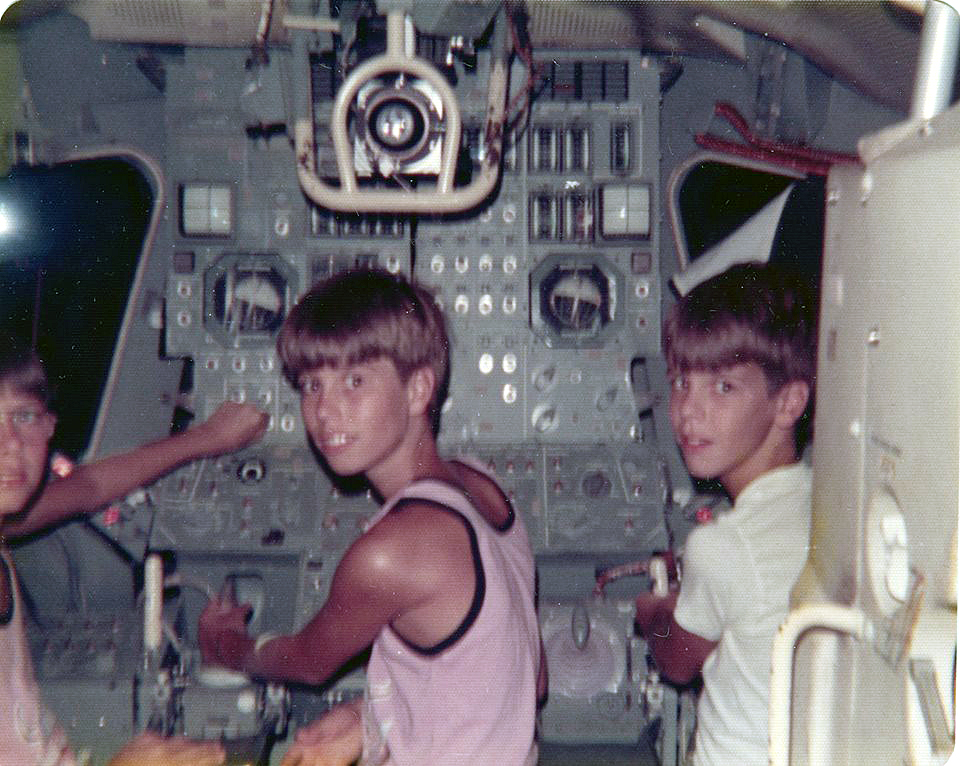
RS: Your Bachelors Degree is in Mechanical Engineering. Why did you pursue that degree, and did you put it into practice after college?
POHLEN: “Watching my father work on NASA projects made engineering look like a lot of fun. I did well in math and science, so engineering seemed a natural. I worked at Martin Marietta for a couple years in their analytical mechanics department—running mathematical models for upcoming rocket flights. Basically, we were trying to imagine how much a rocket’s payload would be shaken during launch before it was launched, and each payload was different. It’s a lot less expensive to run a computer simulation of a launch and find out that it might break a satellite, instead of putting that multimillion-dollar satellite on a rocket and hope for the best.”
RS: You also earned a Masters Degree in Elementary Education. Why did you switch from engineering to education?
POHLEN: “After college I served in the US Peace Corps in Benin, West Africa, where I taught methods of wood conservation. I found out that I liked teaching, something I never tried before. I worked as an engineer after I returned, and soon realized I’d rather be teaching than doing engineering, so I went back to school to get a masters in education.”
RS: What was it the experience of serving in the U.S. Peace Corps in West Africa like for you?
POHLEN: “It was a wonderful, eye-opening experience. The people of Benin were welcoming to me, and I learned a lot. Most days I would go to villages with rural development workers to teach how to build mud stoves—barbeque pits, essentially—that would save wood. Since most people had to find wood or buy wood, it made a real impact in their lives when they used half as much as usual. Plus, it helped save the forests from being cut down.”

RS: In the past you worked for an educational toy company and developed a number of science kits. How important is it in your opinion to expose kids to science and other STEM subjects at a young age? Is there ever too young an age to start teaching them about such things?
POHLEN: “To me, understanding math and science is just as important as understand language and art. And it’s never too early to learn. I believe that some children are told, “Science (or math) is difficult,” and they convince themselves they can’t do it. But with the right teacher, or material, I think science and math are understandable and fun.”
RS: Your present job is the Acquisitions Editor at the Chicago Review Press. What is a typical day at work like for you?
POHLEN: “As an acquisitions editor, I search for new books to publish, but the work doesn’t really start until after those books are turned in. I help authors clarify their writing, to make their books more understandable for a general audience. This means I send most of my workdays reading and editing books in their first drafts.”
RS: You’ve written more than 20 books, with a large number of them being travel books, however you have a unique way of presenting the places, as well as tending to travel off the beaten path. What inspired you to produce such titles as Texas Baby, Doodle America and Oddball Wisconsin?
POHLEN: “Another publisher knew of my travel books and thought I would be a good match for its city- and state-specific baby books. So, because I had done a book titled Oddball Illinois, I then was asked to write a book titled Chicago Baby, and then Doodle Chicago.”
RS: Lyndon Johnson saw that NASA would have broad congressional support by placing NASA centers in multiple states as well as contracting for hardware with companies all across the country. In your Oddball series of books are there any space related places highlighted?
POHLEN: “I included space sites in my Oddball books, but only if there was something odd or unique to be found there. For example, I have the Adler Planetarium in Oddball Illinois because they have the telescope used to discover Pluto. On the other hand, I also have “space” museums that nothing whatsoever to do with science, such as a UFO museum in the Wisconsin Dells (since closed). I certainly hope the reader won’t confuse the two.”
RS: Your last three kids titles – The Apollo Missions for Kids, Albert Einstein and Relativity for Kids, and Gay & Lesbian History for Kids – all include a variety of activities or thought experiments in each book. How did those come to be part of the books?
POHLEN: “Each of these books is part of the “For Kids” book series, and every title is required to have at least 21 activities. These activities are what set them apart from other books on the same subjects. For example, there are dozens of books on Albert Einstein for children, but only my book has hands-on activities to help readers better understand the material. But the idea of including activities wasn’t my idea, it was the publisher’s. If I wanted to do a book for the series, I had to include those projects.”
RS: For a while you were a science teacher in Chicago. Are students in general naturally curious about learning how everything from a cell phone to the Universe works? Is it important that the parents also be hands on in exposing them to the sciences?
POHLEN: “For the most part, the kids I taught loved doing experiments and activities. Those hands-on experiences were important to help them understand how the universe works, better than if they had just read about the subject. Parents should keep this in mind—the more a child experiences science the more likely it is that the child will understand it.”
RS: Among the 21 activities included within The Apollo Missions for Kids are things such as demonstrating the distance from the Earth to the Moon using a basketball and tennis ball, calculating your weight on the Moon, and designing your own mission patch and Personal Preference Kit. How did you come up with all of those activities? Is there one that is your personal favorite?
POHLEN: “I had to write them all, though some are variations of “classic” experiments. My favorite in Apollo is the basketball/tennis ball activity. They are the same relative sizes as the earth and moon, but how far apart should they be placed using the same scale? Almost everyone is shocked to find that they would be 25 feet apart, and it gives the reader an idea of just how far the astronauts traveled.”
RS: The book covers the entire Space Race from the earliest flights of Project Mercury through Apollo 17’s final crewed mission to the Moon. You’ve devoted multiple pages to nearly every mission, giving readers a good understanding of the basics of each mission. The book is extensively researched and includes a list of museums to visit. In your travels to these museums, what has been your favorite museum or exhibit to date?
POHLEN: “One of my favorite space museums is the Cosmosphere in Hutchinson, Kansas. They have rooms and room of artifacts leftover from NASA, from the before the first Mercury flight through the International Space Station. And they don’t just have capsules and space suits, but strange things, like the first Coke can to go to space, and a toilet from a Space Shuttle — I love seeing how they astronauts lived, not just the spacecraft they flew.”
RS: Should we expect an interplanetary edition of the Oddball series some day?
POHLEN: “If I’m lucky!”
RS: Have you ever attended a rocket launch? What was it like?
POHLEN: “I have — the first Viking launch in August 1975. The strangest part, to me, was being able to “see” the shock wave headed our way before we ever heard a thing. The sound of the launch freaked out the birds in the marshes around the pad, and you could see them rising into the sky in an ever-expanding circle. Then the “ring” reached us, and the sound was deafening — it shook your bones. Everyone around us was cheering and shouting “GO!” and cheering as it flew into the distance. There’s a description of the Apollo 8 launch written by Anne Morrow Lindbergh in my book, and it’s almost exactly what I remember on Viking.”
RS: Finally, if you had the chance to go to space and visit anywhere in the solar system, where would you want to go?
POHLEN: “Assuming I could survive, I’d love to see the volcanoes erupt on Io, one of Jupiter’s moons.”
Featured Book: ‘The Apollo Missions for Kids’
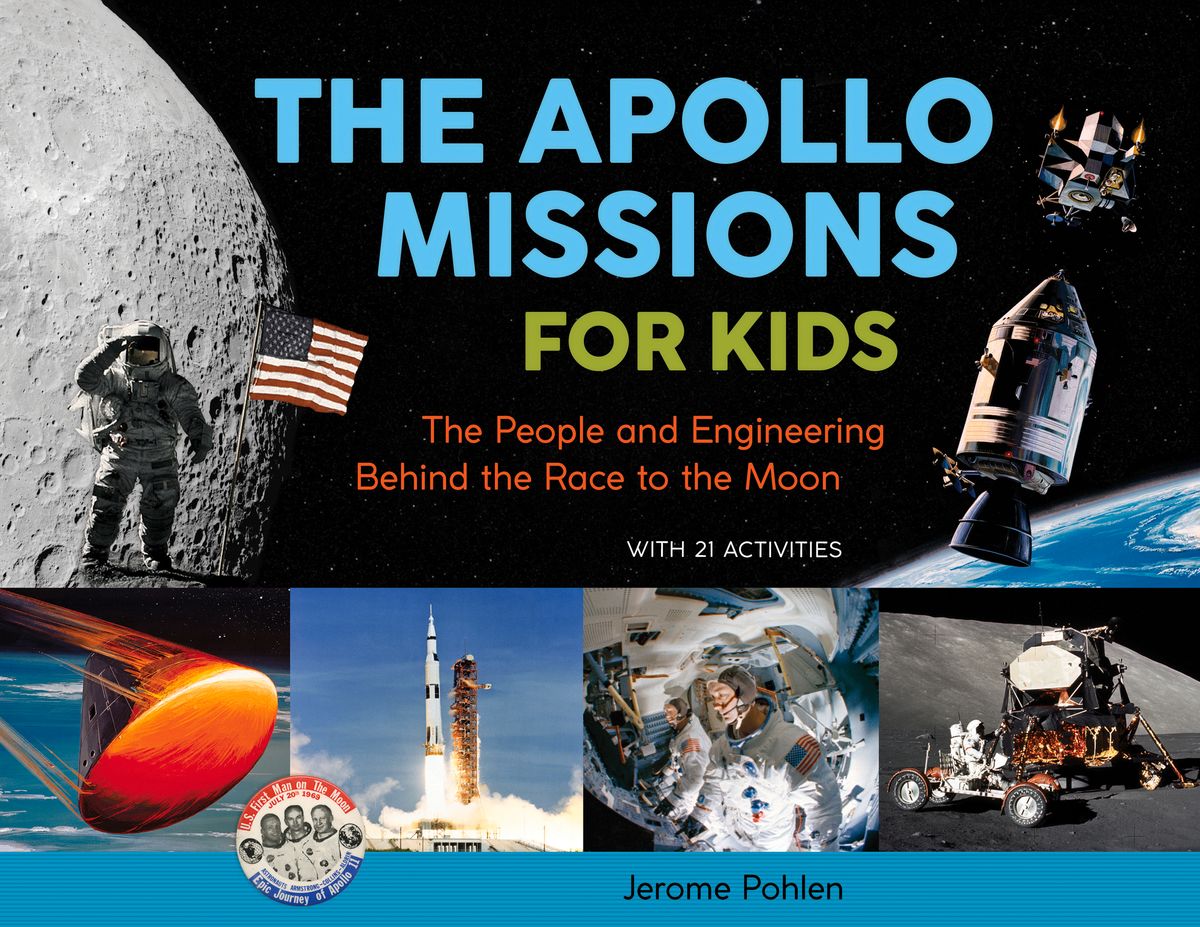 No matter if you lived through the era of the Moon landings or are learning about them for the very first time, The Apollo Missions for Kids is bound to keep your attention. As you read through the book there are 21 different activities for you to perform, ranging from creating your own lunar craters, designing a mission patch, creating your own command module capsule in your living room, identifying the Moon’s features, and determining how much less you would weigh on the lunar surface.
No matter if you lived through the era of the Moon landings or are learning about them for the very first time, The Apollo Missions for Kids is bound to keep your attention. As you read through the book there are 21 different activities for you to perform, ranging from creating your own lunar craters, designing a mission patch, creating your own command module capsule in your living room, identifying the Moon’s features, and determining how much less you would weigh on the lunar surface.
The book opens up with President Kennedy’s challenge issued in 1961 to land an American on the Moon before the end of the decade. From there it gives focus not just to the astronauts who rocketed into space during the Mercury, Gemini and Apollo programs, but also to some of the 400,000 terrestrially-bound workers, scientists, engineers, computer programmers and mathematicians who were so essential to accomplishing Kennedy’s challenge in such a short timeframe.
A spotlight is shone upon all of the Apollo missions from the Apollo 1 pad fire, to the six Moon landings, before concluding with the Apollo-Soyuz Test Project. Telling the story of each mission through the perspective of not just the astronauts, but their families, the ground controllers as well as the engineers and technicians at NASA and the many subcontractors that made reaching the Moon possible, Pohlen brings the lunar program to life in an entertaining and informative way.
It is possible to devour the book entirely in one setting. However, as a book for children, the narrative flow is conducive to frequent breaks. The book may very well come to life more in this matter as it will afford the reader an opportunity to digest the abundant photos, side features, illustrations, and to perform the many activities scattered through the 160 pages.
As The Apollo Missions for Kids reaches its conclusion, the post-NASA life of the Apollo astronauts is touched upon briefly. As the only 24 humans to ever witness the whole of the Earth from outer space, each developed a greater appreciation for our home planet and its fragility. Apollo 8’s Bill Anders said “When I looked back and saw that tiny Earth, it snapped my world view.”
Included at the end of the book is an extensive section of endnotes, a glossary of acronyms, index, and a list of other books, films and places to visit to learn more about the Apollo program.
Ad astra per litterarum!
Praise from others
“The greatest exploring voyages in history, the Apollo missions to the moon still awe and inspire half a century on. In clear and exciting prose, Jerome Pohlen brings the Apollo story to a new generation of explorers.”
— Tom Jones, four-time Space Shuttle astronaut
“[A] detailed and generously illustrated overview…An ideal candidate for STEM collections.”
— Booklist
“An engrossing portrayal…at once broad in scope and rich in specific details.”
— Kirkus Reviews
Review book details
Age Range: 9 and up
Grade Level: 4 – 6
Paperback: 160 pages
Publisher: Chicago Review Press (June 4, 2019)
Language: English
ISBN-10: 0912777176
ISBN-13: 978-0912777177
Goodreads’ Rating Details:

